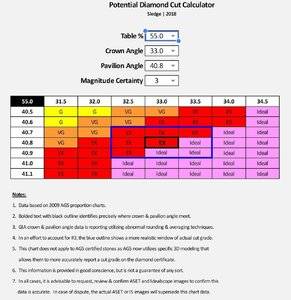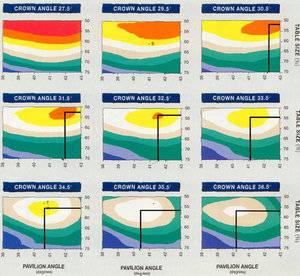Monkey1229
Rough_Rock
- Joined
- Dec 29, 2018
- Messages
- 20
Me too“Denied access” ??
HCA score:0.7“Denied access” ??
What is the HCA score on it?
I don’t know I need help I’ve been looking for a perfect stone for a very long time but I can’t get anywhere I have $30K budget hoping to get the stone as close to 3 carats with GIAAdd me to the denied list, lol.
Either way -- why a 33/40.8 combo? What is the reasoning? IMO, the crown is too shallow and pavilion not steep enough to offset the crown so it's not the most complimentary angle, but it's not horrible either.
Which gets me back to, why this stone?
Interesting - don't often seem to get small tables with low crown angles??It’s a 2.6ct H/VS1
T55/D60.8/CA33/PA40.8
HCA0.7
GIA #1315761687
$28.5k
Video looks dreamy.
@sledge thank you so much!
Add me to the denied list, lol.
Either way -- why a 33/40.8 combo? What is the reasoning? IMO, the crown is too shallow and pavilion not steep enough to offset the crown so it's not the most complimentary angle, but it's not horrible either.
Which gets me back to, why this stone?
Garry H said:say 40.75 P and 34.5 C is ideal , then for every 1 degree + pavilion angle subtract 5 degrees from the crown angle.
Just to note 40.8 is nicely complementary to 33. 40.8 is compatible with a wide range of shallower crowns than yours expect.
So you can see the pavilion is highly compatible with various angles.
34.5 / 40.75 transformed using the above fornula 33.25/40.8
I’m not following that formula that Garry mentioned. Is it every +/- 1 degree of crown angle, you -/+ 0.05 degrees pavilion angle?
I got lost on Gary’s formula too and am sure it’s missing a decimal or two ???
@Monkey1229 , hi, I’m not sure if this is allowed, @psadmin please delete if not, I’m kind of a newbie so sorry if I’m violating any rules. I have a GIA triple x 2.82ct (9.05 x 9.09) J SI1 eye clean (table 58, ca 34, pa 40.that I’m trying to sell so I could get myself a crafted by infinity. Would you be interested? I havent listed it anywhere yet, only started thinking’s about it last week.

PA 40. 8 why did it show up as an emoji?
Just to note 40.8 is nicely complementary to 33. 40.8 is compatible with a wide range of shallower crowns than yours expect.
So you can see the pavilion is highly compatible with various angles.
34.5 / 40.75 transformed using the above fornula 33.25/40.8

19 years ago when I developed HCA I was first to factor spread into a grade.@sledge, You'll notice HCA is much more tolerant of shallow combinations than AGS. If you plugin 33/40.5 you'll still hit excellent.
Could you have another go at this Karl? Very hard to understand!33 works with 40.8 and with 60 table is one of the better 60/60 combos ags0 potential.
When talking a modern ideal cut its a bit shallow, anything under 34 is a bit shallow.
Garry I think your formula is being misunderstood.
It says that the inverse crown relationship is the same between the 2 using your formula.
That does not mean they are equivalent because the CH is different and the uppers are also impacted as well as lgf angle..
Remember there are 5 things that set the upper girdle angles: table size, crown angle, star length, and painting/digging.
As you move the crown angle up and down they have to be taken into account.
Likewise moving the pavilion angle moves the lower girdle angles for any given lgf%.
You can run into lower girdle angle issues even is the pavilion mains angle and crown angle inverse relationship is good.
While the crown pavilion angle relationship is the building block it is not the whole story.
It also works for a narrow range of angles then it fails to produce a good looking diamond the larger the table the sooner it fails.
So the bottom line dont use the formula as this one is good so another one that follows the formula is also good.
It is more of an academic study or part of a bigger whole than useful for selection.
I think Karl is saying that one cannot rely on the fixed relationship between crown and pavilion angles - where one falls, the other rises - alone, because the table size, LGF length and other factors need to be taken into account??Could you have another go at this Karl? Very hard to understand!
Basically yes.I think Karl is saying that one cannot rely on the fixed relationship between crown and pavilion angles - where one falls, the other rises - alone, because the table size, LGF length and other factors need to be taken into account??
Well yes, and that holds for any set of proportions. But the major factor is the inverse crown and pavilion angle relationship. I discovered it in the 1980's and tried hard to get the GIA 'Brilliance' 1998 article researchers to understand it. But geochemists are not great physicists.I think Karl is saying that one cannot rely on the fixed relationship between crown and pavilion angles - where one falls, the other rises - alone, because the table size, LGF length and other factors need to be taken into account??
